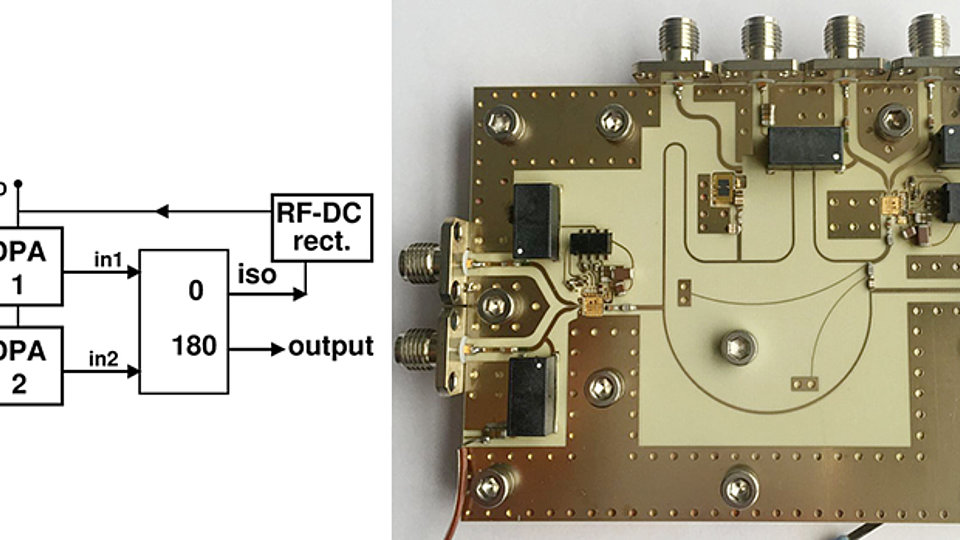Digital microwave power amplifier with energy recovery
Digital PA system with energy recovery concept (l.) and realized digital PA module (r.) including 2 GaN DPAs, wideband 180° hybrid coupler and RF-DC rectifier, size: 85 x65 mm2
Next-generation wireless communication infrastructure demands for high flexibility, low cost, and high efficiency. These requirements are complemented by the growing needs towards wideband, multi-band, and multi-standard features. As the RF power amplifier (PA) is the last analog part in the base-stations, extensive research efforts have been devoted to digital PA realizations within the last years.
One of the major problems on the way to a fully digital transmitter is the low overall power-added efficiency (PAE) of digital microwave PAs (DPAs) even at full-scale. Hence, they are not yet competitive to analog concepts like envelope tracking (ET). One approach to overcome this problem is energy recovery. The binary pulse sequences in a DPA contain a lot of spectral power outside the desired band, particularly in the back-off case. This power can be converted to DC and then reused to assist in the supply of the PA, thus improving efficiency at power back-off (PBO).
Recently, FBH presented at the IEEE International Microwave Symposium 2016 in San Francisco a DPA system for 900 MHz applying energy recovery. The output of two digital PAs is combined with a rat-race coupler. The out-of-band energy is collected at the isolated port. A charge-pump voltage-doubler rectifier circuit (RF-DC rect.) converts this signal to DC and this power can assist in supplying the PA.
The DPA system reaches a maximum Pout of 7.5 W and a peak PAE of 42%. Without energy recovery, final-stage efficiency ηD drops from 70% for full-scale (0 dB PBO) to 13% at 15.2 dB PBO. Due to digital Doherty operation, a second peak in efficiency with 58% at around -6 dB PBO is achieved. By applying energy recovery the module now reaches ηD values of 74% and 52% at -6 dB and -10 dB PBO, respectively (23% at -15.2 PBO).
These results demonstrate the significant improvement in final-stage drain efficiency when applying energy recovery technique in digital PA systems. Performance will improve even more if truly digital modulated signals are applied.
Publication:
A. Wentzel, W. Heinrich, “Digital Microwave Power Amplifier with Energy Recovery”, IEEE MTT-S International Microwave Symposium Digest 2016, THIF2-1, San Francisco, USA.

